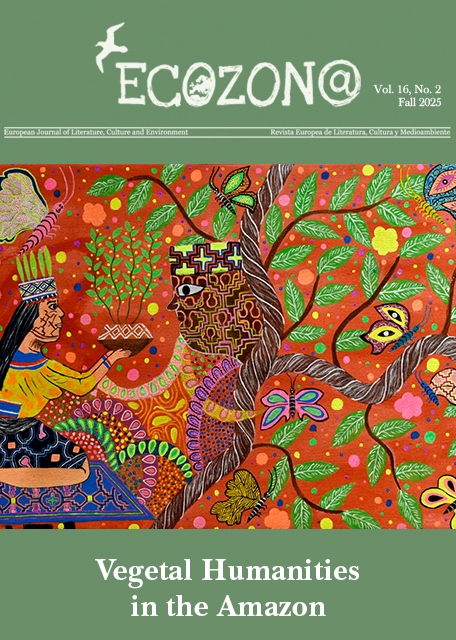Dislocations and Ecologies. the Disruption of the Experience of London in Peter Ackroyd, Iain Sinclair and Gilbert & George
DOI :
https://doi.org/10.37536/ECOZONA.2011.2.1.394Mots-clés :
memory – identity – ecology – dislocation - experienceRésumé
London exerts attraction and repulsion upon travellers, writers and artists alike. Its past is overshadowed by the never-ending process of change, yet a close investigation helps unveiling hidden parts of a collective memory. Peter Ackroyd, Iain Sinclair and Gilbert & George have explored the memory of London through the prism of cultural studies, psychogeography or contemporary art. London: The Biography by Peter Ackroyd, Lights Out for the Territory, London Orbital by Iain Sinclair and the 20 London E 1 Pictures by Gilbert & George may serve as a basis for retrieving fragile realms of memory. We may wonder whether these realms cannot be likened to « ecology of knowledge ». If ecology designates an environment regulated by specific rules and mechanisms, what do “ecologies of knowledge” refer to in the urban context? Besides, the nature of the relationship between the experience of London and the ecology of knowledge prompts questions. Does the experience of London dislocate the artistic universes created by Peter Ackroyd, Iain Sinclair and Gilbert & George? Or do the artistic works partake in the dislocation of urban experience? ?My contention in this paper is to unveil the ways in which the polymorphism of the city is translated into writerly and iconographic codes. As the understanding of the urban ecology keeps receding, similarly the works adopt process and metamorphosis as structuring principles. ?First, the destabilising exploration of London shall be assessed by its impact upon the physical experience, and the renegotiation of concepts such as body, empiricism, and the spirit of the place. Then, the frustrating exploration of London may be analysed through literary and artistic devices that echo the dislocation in the works. Eventually, these works will lead us to consider the dis-membering of the city body as the only means to the re-membering of London.
Londres ejerce atracción y repulsión entre los viajeros, artistas y escritores. Su pasado, aunque ocultado por el proceso de cambio que caracteriza la ciudad, se deja domesticar, desvelando una memoria colectiva descuidada. Peter Ackroyd, Iain Siclair y Gilbert & George han registrado la memoria de Londres a través del prisma de estudios culturales de la psicogeografía o de las artes plásticas contemporáneas. London : The Biography de Peter Ackroyd, Lights Out For the Territory, London Orbital de Iain Sinclair y los 20 London E 1 Pictures de Gilbert & George sirven de punto de partida para la exploración de trozos de memoria que van desvaneciéndose. ¿Si la ecología designa un entorno regulado por mecanismos específicos, que mecanismo regula esta ecologia urbana ? En este artículo, analizaremos la dislocación de la ciudad y su codificación textual e iconográfica. Dado que la comprensión de la ecología urbana se revela problemática, las obras adoptan a su vez el proceso y la metamorfosis como principios estructurantes. ¿Como la ecologia urbana y los universos artisticos ecologia artistica interactuan : ¿la experiencia de Londres disloca los universos artísticos de Peter Ackroyd , Iain Sinclair et Gilbert & George? ¿O sus obras participan en la dislocación de la experiencia urbana? En primer lugar, la experiencia desestabilizante de Londres se valorará a partir de su impacto sobre la experiencia física, ajustando conceptos como el cuerpo, el empirismo o el alma del lugar. Luego, la exploración de Londres se analizará con procedimientos que imitan la dislocación. Por fin, el análisis del corpus nos llevará a contemplar el desmembramiento del cuerpo de la ciudad como único medio para encontrarse con la memoria evanescente de Londres..
Téléchargements
Téléchargements
Fichiers supplémentaires
Publié-e
Numéro
Rubrique
Licence
Authors who publish with this journal agree to the following terms:
a) Authors retain copyright and grant the journal right of first publication with the work simultaneously licensed under a Creative Commons Attribution License that allows others to share the work with an acknowledgement of the work's authorship and initial publication in this journal (CC BY-NC for articles and CC BY-NC-ND for creative work, unless author requests otherwise.
b) Authors are able to enter into separate, additional contractual arrangements for the non-exclusive distribution of the journal's published version of the work (e.g., post it to an institutional repository or publish it in a book), with an acknowledgement of its initial publication in this journal.
c) Authors are permitted and encouraged to post their work online (e.g., in institutional repositories or on their website) prior to and during the submission process, as it can lead to productive exchanges, as well as earlier and greater citation of published work (See The Effect of Open Access).










